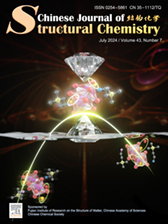
Cover Picture
Pressure-induced emission in 0D metal halide (EATMP)SbBr5 by regulating exciton-phonon coupling
Jiayuan Liang, Xin Mi, Songhao Guo, Hui Luo, Kejun Bu, Tonghuan Fu, Menglin Duan, Yang Wang, Qingyang Hu, Rengen Xiong, Peng Qin*, Fuqiang Huang, Xujie Lü*
Submit a Manuscript
Pressure-induced emission in 0D metal halide (EATMP)SbBr5 by regulating exciton-phonon coupling
Jiayuan Liang, Xin Mi, Songhao Guo, Hui Luo, Kejun Bu, Tonghuan Fu, Menglin Duan, Yang Wang, Qingyang Hu, Rengen Xiong, Peng Qin*, Fuqiang Huang, Xujie Lü*
Submit a Manuscript
首页>List of Issues>2024>July 2024
| Vol. 43, Issue 7
>
Short Communication
< PREV
Short Communication
NEXT >
Mechanistic analysis of Co2VO4/X (X = Ni, C) heterostructures as anode materials of lithium-ion batteries
Mianying Huang, Zhiguang Xu*, Xiaoming Lin*
Chin. J. Struct. Chem., 2024, 43: 100309. DOI: 10.1016/j.cjsc.2024.100309
July 15, 2024
ABSTRACT
In summary, we synthesized
Co2VO4/Ni and Co2VO4/C with
heterogeneous structures and evaluated their performance as anode materials for
lithium-ion batteries. Using first-principles DFT calculations, we examined the
impact of metallic nickel and non-metallic carbon on the crystal structure,
migration barrier, adsorption energy, and electronic properties of Co2VO4/X
(X = Ni, C). Our results indicated that Co2VO4/Ni
exhibited higher active electron density, leading to enhanced lithium-ion
diffusion and superior rate performance. Conversely, Co2VO4/C
demonstrated superior adsorption performance and greater stability for lithium
ions, resulting in enhanced cycling performance. However, the limited capacity
of carbon materials restricted the overall capacity of Co2VO4/C.
Therefore, the metal heterostructure exhibited a higher reversible capacity.
This study provides fundamental insights into the influence of these
heterostructures on the lithium-ion intercalation mechanism, contributing to
the design and development of improved anode materials for lithium-ion
batteries.







